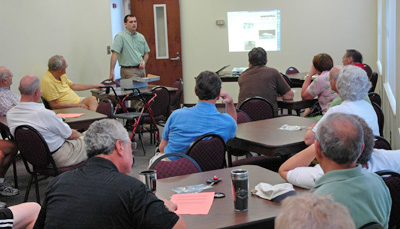
The current cicada infestation in the Lakelands region was the topic when 25 to 30 Savannah Lakes Village residents gathered at the Activity Center on May 10 to hear a presentation by Dr. Mark Pilgrim, assistant professor of biology at Lander University. Pilgrim is a microbiologist and said his specialty is microbes, much smaller bugs such as bacteria and viruses. But his curiosity prompted him to learn more about cicadas, which have swarmed by the billions in parts of South Carolina and several other states.
The title of his presentation before the SLV Discussion Group was "The Magic of Magicicada: The Bugs that are Bugging Us."
He told the group the region is in the middle of a six- to eight-week infestation, which followed the emergence of cicadas from below ground where they went through five stages of development over a period of 13 years. In the north, their underground growing cycle is about 17 years. Pilgrim said cicadas emerge in different areas in different years.
They are called periodical cicadas unlike the annual species, which can appear every one or two years but in much fewer numbers. One acre of land can produce millions of periodicals.
Pilgrim said cicadas have a very brief life span, living just long enough to mate and lay eggs. He described the almost incessant buzzing noise they produce as the chorus of adult males seeking female mating partners.
Cicadas are not related to locusts but to leafhoppers and the damage they cause is usually limited. "Orchard farmers will delay planting when they know cicadas are about to emerge because very young trees are susceptible to damage," Pilgrim said.
They prefer to lay their eggs in hardwoods and they feed off the sap. After the larvae hatch in tree branches, they migrate below ground where they will remain until their emergence 13 years later.
Pilgrim said they are not harmful to humans or animals. Some humans eat cicadas, which are very high in protein, and there are several cookbooks available with recipes for preparing them in a variety of ways.
He said fish might not be biting as usual this year because they are also feasting on cicadas. The bright spot, he added, is that fish will probably be bigger and fatter next season.
Other predators include birds, snakes, frogs, lizards, and predatory wasps. Some dogs even seem to find them a delicacy.
Pilgrim showed samples of cicadas that he had collected at his home and provided magnifying lenses so his audience could get close-up views.
When asked how long the cicada infestation could be expected to last, Pilgrim replied that they should begin to disappear by the second week in June.